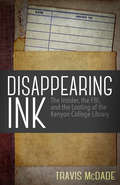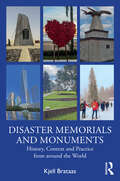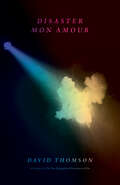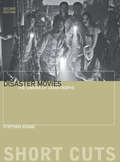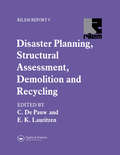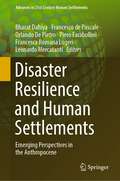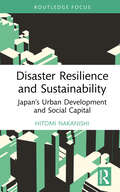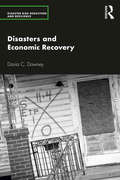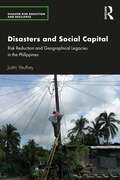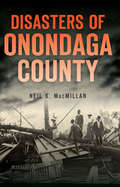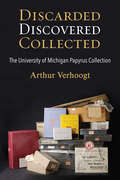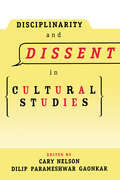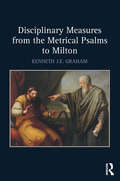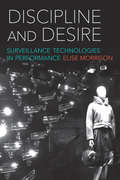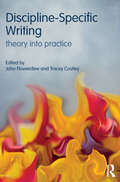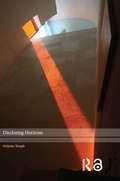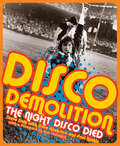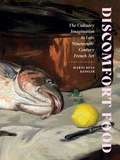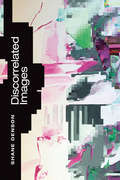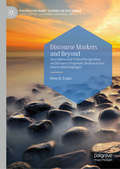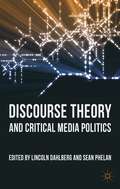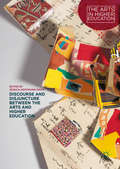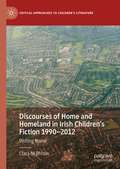- Table View
- List View
Disappearing Ink: The Insider, the FBI, and the Looting of the Kenyon College Library
by Travis McDadeThe remarkable true story of the document heist that shocked the world. Like many aspiring writers, David Breithaupt had money problems. But what he also had was unsupervised access to one of the finest special collections libraries in the country. In October 1990, Kenyon College hired Breithaupt as its library’s part-time evening supervisor. In April 2000, he was fired after a Georgia librarian discovered him selling a letter by Flannery O’Connor on eBay, but that was only the tip of the iceberg: for the past ten years, Breithaupt had been browsing the collection, taking from it whatever rare books, manuscripts, and documents caught his eye—W. H. Auden annotated typescripts, a Thomas Pynchon manuscript, and much, much more. It was a large-scale, long-term pillaging of Kenyon College’s most precious works. After he was caught, the American justice system looked like it was about to disappoint the college the way it had countless rare book crime victims before—but Kenyon, refused to let this happen . . .
Disarmed: The Story of the Venus de Milo
by Greg CurtisIn the spring of 1820, on the Aegean island of Melos, an unsuspecting farmer was digging for marble building blocks when he unearthed the statue that would come to be known as the Venus de Milo. From the moment of its discovery a battle for possession ensued and was won, eventually, by the French. Touted by her keepers in the Louvre as the great classical find of the era, the sculpture gained instant celebrity–and yet its origins had yet to be documented or verified. From the flurry of excitement surrounding her discovery, to the raging disputes over her authenticity, to the politics and personalities that have given rise to her mystique, Gregory Curtis has given us a riveting look at the embattled legacy of a beloved icon and a remarkable tribute to one of the world’s great works of art.
Disaster Memorials and Monuments: History, Context and Practice from around the World
by Kjell BrataasBringing together the historical and the contemporary, the political and the personal, Disaster Memorials and Monuments: History, Context and Practice from around the World presents a wide-ranging understanding and exploration on memorials and monuments built in the aftermath of accidents, natural disasters and acts of violence.Disaster management expert, Kjell Brataas, provides a compassionate voice to difficult and complex situations as well as practical advice based on lessons learned through academic research, site visits and personal experience. Brataas illustrates a wide range of monuments and memorial projects from all over the world and explains the process of their creation and the challenges that occur in memorialization processes. He further proposes strategies for dealing with trials and controversies in similar future developments.Features include: Personal interviews with key stakeholders in the field of memorializing, psychology and victim support, who have first-hand experience with memorial projects Insights, lessons learned and advice from scholars, professors, politicians, support group leaders, survivors, bereaved, community leaders and neighbors Reporting on more than 80 memorials from around the world, including New Zealand, Canada, the United States, Sahara, Chile, Japan and South Korea Suggested reading, including books, reports and presentations on the topic Disaster Memorials and Monuments: History, Context and Practice from around the World is important reading for all practicing professionals, for those who study and teach the importance and the process of developing memorials and monuments and for everyone interested in crisis management and the aftermath of disasters.
Disaster Mon Amour
by David ThomsonA deep—and darkly comic—dive into the nature of disasters, and the ways they shape how we think about ourselves in the world &“In this brilliant book, David Thomson tells the story of how we came to make disaster and catastrophe our best friends—how we let terror cocoon and take over our imaginations to avoid seeing the things that really frighten us. Riveting and totally original.&”—Adam Curtis, BBC filmmaker and political journalist &“Erudite. . . . Engaging. . . . A cri de coeur about art&’s struggle to keep up with reality.&”—Kirkus Reviews Audiences swell with the scale of disaster; humans have always been drawn to the rumors of our own demise. In this searching treatment, noted film historian David Thomson examines iconic disasters, both real and fictional, exposing the slippage between what occurs and what we observe. With reportage, film commentary, speculation, and a liberating sense of humor, Thomson shows how digital culture commodifies disaster and sates our desire to witness chaos while suffering none of its aftereffects. Ranging from Laurel and Hardy and Battleship Potemkin to Cormac McCarthy&’s The Road, and from the epic San Andreas to the intimate Don&’t Look Now, Thomson pulls back the curtain to reveal why we love watching disaster unfold—but only if it happens to others.
Disaster Movies
by Stephen KeaneStephen Keane's history of the disaster genre offers a detailed analysis of films such as The Towering Inferno, Independence Day, Titanic, and The Day After Tomorrow. He looks at the ways in which disaster movies can be read in relation to both contextual considerations and the increasing commercial demands of contemporary Hollywood. In this second edition, he adds new material regarding cinematic representations of disaster in the wake of 9/11 and an analysis of disaster movies in light of recent natural disasters. Keane continually reworks this previously unexplored genre.
Disaster Movies: The Cinema of Catastrophe (Short Cuts)
by Stephen KeaneStephen Keane's history of the disaster genre offers a detailed analysis of films such as The Towering Inferno, Independence Day, Titanic, and The Day After Tomorrow. He looks at the ways in which disaster movies can be read in relation to both contextual considerations and the increasing commercial demands of contemporary Hollywood. In this second edition, he adds new material regarding cinematic representations of disaster in the wake of 9/11 and an analysis of disaster movies in light of recent natural disasters. Keane continually reworks this previously unexplored genre.
Disaster Planning, Structural Assessment, Demolition and Recycling: Report Of Task Force 2 Of Rilem Technical Committee 121-drg, Guidelines For Demolition And Reuse Of Concrete And Masonry
by E.K. Lauritzen C. de PauwThis book contains general recommendations for site clearing after man-made and natural disasters. It provides guidelines on the demolition of damaged structures and the reuse of demolition and construction materials. It has been prepared by an international task force originating from cooperation between RILEM and UNESCO.
Disaster Resilience and Human Settlements: Emerging Perspectives in the Anthropocene (Advances in 21st Century Human Settlements)
by Bharat Dahiya Francesco De Pascale Orlando De Pietro Piero Farabollini Francesca Romana Lugeri Leonardo MercatantiThis book presents emerging perspectives on disaster resilience and human settlements in the larger context of the Anthropocene. The chapters explore urban and rural perspectives focusing on the current and emerging perspectives on disaster resilience through a holistic approach, involving scientists, humanists, planners, policymakers, and professionals in the global debate.
Disaster Resilience and Sustainability: Japan’s Urban Development and Social Capital (Routledge Research in Sustainable Planning and Development in Asia)
by Hitomi NakanishiThis book examines urban planning and infrastructure development in Japanese cities after the second world war as a way to mitigate the risks of disasters while pursuing sustainable development. It looks at the benefits of social capital and how communities organise to tackle problems during the recovery phase after a disaster. The book also illustrates with case studies to highlight community attitudes which improve recovery outcomes. The book underlines challenges such as ageing and depopulation which Japan would face should the next disaster occur. These demographic shifts are causing difficulties among neighbourhood associations at a time when communities need to effectively support each other. Nakanishi explains why overcoming these societal issues is imperative for sustainability and the need for a comprehensive approach which would integrate smart technology. This book will be of interest to scholars in city development and planning, urban studies and human geography, as well as those interested in building resilient communities.
Disasters and Economic Recovery (Disaster Risk Reduction and Resilience)
by Davia C. DowneyDisasters and Economic Recovery provides perspectives on the economic issues that emerge before, during, and after natural disasters in an international context, by assessing the economic development patterns that emerge before and after disaster. This book will provide a historical overview of emergency management policy and previous responses to disasters in each country, as well as the policy learning that occurred in each case leading up to the disasters under analysis. The book highlights four cases: New Orleans; Christchurch, New Zealand; the Japan earthquake and tsunami; and Hurricane Sandy in the Northeastern United States. The book places important focus on the specific collaborative developments unique to the rebuilding of each place’s economy post-disaster. Using time-series data, the book shows the emergence of new industries and job hiring patterns in the immediate aftermath, as well as provides a picture of the economic performance of each country in the years following each event. Looking at the economic development policies pre- and post-disaster, readers will glean important lessons on how to build resilient economies within the disaster framework, highlighting the differences in approaches to rebuilding local economies in places with varying levels of governmental capacity post-disaster to inform policymakers, scholars, and the disaster relief community as they plan their response to future disasters.
Disasters and Social Capital: Risk Reduction and Geographical Legacies in the Philippines (Disaster Risk Reduction and Resilience)
by Justin VeutheyThis book analyzes social capital and preparations for natural hazards in the Philippines. It emphasizes the importance of inequalities, contextualization, and scale, while also underlining the significance of historical and political contexts to better understand social dynamics. Social capital continues to be a debated concept, but it can be useful for thinking about how human societies interact with natural hazards. This book contributes to the growing scientific inquiries which have begun to address the connections between social capital and “natural” disasters. Chapters explore the links between these two fields of knowledge by analyzing the Filipino situation in general, as well as detailing a specific case study of a rural municipality in the Eastern Visayas region. The book’s central argument is that economic inequality is detrimental to social capital which then has negative repercussions on preparing for natural hazards. In an analysis at several geographical scales, Justin shows how inequality, via social capital, makes societies more at risk of having natural hazards turn into disasters. The book argues that a cautious use of the concept of social capital, which is cognizant of the historical and geographical complexities of the context it is applied to, has the potential to improve the way people collectively prevent hazards from turning into disasters. It is essential reading for students, scholars, disaster risk management practitioners, policymakers, and anyone seeking to understand the complexities of climate change, inequality, and crisis resilience.
Disasters of Onondaga County (Disaster)
by Neil K. MacmillanThe city of Syracuse and Onondaga County have a long and storied history of natural and man-made calamity. Although often considered a moderate weather region, Mother Nature has not spared it from destruction. A tornado devastated picturesque Longbranch Park in 1912, and the rare Hurricane Hazel reached Onondaga’s borders in 1954. A fire ravaged Syracuse’s famed Bastable Block building in 1923. During a children’s concert and festival, the floor of the Central Baptist Church collapsed, tragically claiming scores of lives and injuring more than one hundred. Author and historian Neil MacMillan charts the history of Onondaga County catastrophes.
Discarded, Discovered, Collected: The University of Michigan Papyrus Collection
by Arthur VerhoogtDiscarded, Discovered, Collected provides an accessible introduction to the University of Michigan’s collection of papyri and related ancient materials, the widest and deepest resource of its kind in the Western hemisphere. The collection was founded in the early part of the 20th century by University of Michigan Professor of Classics Francis W. Kelsey. His original intention was to create a set of artifacts that would be useful in teaching students more directly about the ancient world, at a time when trips to ancient sites were much harder to arrange. Jointly administered by Michigan’s Department of Classical Studies and its Library, the collection has garnered significant interest beyond scholarly circles and now sees several hundred visitors each year. Of particular note among its holdings are sixty pages of the earliest known copy of the Epistles of St. Paul, which are often featured on tours of the collection by groups from religious institutions. Arthur Verhoogt, one of the current stewards of the Papyrology Collection, provides clear, insightful information in an appealing style to engage general readers and scholars alike. Extensively illustrated with some of the collection’s more spectacular pieces, this volume describes what the collection is, what kinds of ancient texts it contains, and how it has developed from Francis Kelsey’s day to the present. Verhoogt describes in detail how people who study papyri carry out their work, and how papyri contribute to our understanding of various aspects of the ancient Greco-Roman world. Translations of the ancient texts are presented so that the reader can experience some of the excitement that comes with reading original documents from many centuries ago.
Disciplinarity and Dissent in Cultural Studies
by Cary Nelson Dilip Parameshwar GaonkarFirst published in 1996. Routledge is an imprint of Taylor & Francis, an informa company.
Disciplinary Measures from the Metrical Psalms to Milton
by Kenneth J.E. GrahamDisciplinary Measures from the Metrical Psalms to Milton studies the relationship between English poetry and church discipline in four carefully chosen bodies of poetry written between the Reformation and the death of John Milton. Its primary goal is to fill a gap in the field of Protestant poetics, which has never produced a study focused on the way in which poetry participates in and reflects on the post-Reformation English Church's attempts to govern conduct. Its secondary goal is to revise the understandings of discipline which social theorists and historians have offered, and which literary critics have largely accepted. It argues that knowledge of the early modern culture of discipline illuminates some important poetic traditions and some major English poets, and it shows that this poetry in turn throws light on verbal and affective aspects of the disciplinary process that prove difficult to access through other sources, challenging assumptions about the means of social control, the structures of authority, and the practical implications of doctrinal change. More specifically, Disciplinary Measures argues that while poetry can help us to understand the oppressive potential of church discipline, it can also help us to recover a more positive sense of discipline as a spiritual cure.
Discipline and Desire: Surveillance Technologies in Performance
by Elise MorrisonDiscipline and Desire examines how surveillance technologies, when placed within the frames of theater and performance, can be used to critique and reimagine the politics of surveillance in everyday life. The book explores how rapidly proliferating surveillance technologies, including drones, CCTV cameras, GPS tracking systems, medical surveillance equipment, and facial recognition software, can be repurposed through performance to become technologies of ethical witnessing, critique, and action. While the subject of surveillance continues to provoke fascination and debate in mainstream media and academia, opportunities to critically reflect upon and, more importantly, to imagine alternative, creative responses to living in a rapidly expanding surveillance society have been harder to find. Author Elise Morrison argues that such opportunities are being created through the growing genre of "surveillance art and performance," defined as works that centrally employ technologies and techniques of surveillance to create theater, installation, and performance art. Introducing readers to a broad range of surveillance art works, including the work of artists and activists such as Surveillance Camera Players, Jill Magid, Steve Mann, Hasan Elahi, Wafaa Bilal, Blast Theory, Electronic Disturbance Theater, George Brant, Janet Cardiff, Mona Hatoum, and Zach Blas, Discipline and Desire provides a practical and analytical framework that can aid the diverse pursuits of new media-arts practitioners, performance scholars, activists, and hobbyists interested in critical and creative uses of surveillance technologies.
Discipline-Specific Writing: Theory into practice
by John Flowerdew Tracey CostleyDiscipline-Specific Writing provides an introduction and guide to the teaching of this topic for students and trainee teachers. This book highlights the importance of discipline-specific writing as a critical area of competence for students, and covers both the theory and practice of teaching this crucial topic. With chapters from practitioners and researchers working across a wide range of contexts around the world, Discipline-Specific Writing: Explores teaching strategies in a variety of specific areas including science and technology, social science and business; Discusses curriculum development, course design and assessment, providing a framework for the reader; Analyses the teaching of language features including grammar and vocabulary for academic writing; Demonstrates the use of genre analysis, annotated bibliographies and corpora as tools for teaching; Provides practical suggestions for use in the classroom, questions for discussion and additional activities with each chapter. Discipline-Specific Writing is key reading for students taking courses in English for Specific Purposes, Applied Linguistics, TESOL, TEFL and CELTA.
Disclosing Horizons: Architecture, Perspective and Redemptive Space
by Nicholas TempleThis study examines the influence of perspective on architecture, highlighting how critical historical changes in the representation and perception of space continue to inform the way architects design. Since its earliest developments, perspective was conceived as an exemplary form of representation that served as an ideal model of how everyday existence could be measured and ultimately judged. Temple argues that underlying the symbolic and epistemological meanings of perspective there prevails a deeply embedded redemptive view of the world that is deemed perfectible. Temple explores this idea through a genealogical investigation of the cultural and philosophical contexts of perspective throughout history, highlighting how these developments influenced architectural thought. This broad historical enquiry is accompanied by a series of case-studies of modern or contemporary buildings, each demonstrating a particular affinity with the accompanying historical model of perspective.
Disco Demolition: The Night Disco Died
by Bob Odenkirk Paul Natkin Dave Hoekstra Steve Dahl"If you were young and shiftless--and viscerally repulsed by Abba--Steve Dahl was a god. And you were drawn to Disco Demolition." --ESPN.com.In the late 1970s, disco dominated radio airwaves, much to the dismay of rock music fans. To boost attendance at Comiskey Park, the White Sox and Chicago DJ legend Steve Dahl collaborated to host Disco Demolition on July 12, 1979. Admission to the park was ninety-eight cents and a disco record. Records were destroyed on the field between games, declaring absolutely how rock fans felt about disco.Attendance exceeded fifty thousand, far beyond anyone's estimations, and when fans stormed the field for the demolition, chaos ensued. Police cleared the field, Comiskey Park was evacuated, and the second game was cancelled--for the first time in MLB history. In collaboration with Steve Dahl, Disco Demolition examines the night that changed America's disco culture forever, featuring a foreword by Bob Odenkirk and over thirty interviews with sports and music icons, including Rick Nielsen of Cheap Trick and KC and the Sunshine Band, conducted by journalist Dave Hoekstra. Also featuring a foreword by actor Bob Odenkirk (Better Call Saul, Breaking Bad) and photographs by Paul Natkin.Steve Dahl is an American radio personality and former columnist for the Chicago Tribune.Dave Hoekstra is a former columnist for the Chicago Sun-Times and a longtime radio host for WGN.Paul Natkin has photographed The Rolling Stones, Keith Richards, Brian Wilson, and many others. He was an official photographer of the Oprah Winfrey Show, and has shot magazine covers for Newsweek, Ebony, Spin, and People.
Discomfort Food: The Culinary Imagination in Late Nineteenth-Century French Art
by Marni Reva KesslerAn intricate and provocative journey through nineteenth-century depictions of food and the often uncomfortable feelings they evokeAt a time when chefs are celebrities and beautifully illustrated cookbooks, blogs, and Instagram posts make our mouths water, scholar Marni Reva Kessler trains her inquisitive eye on the depictions of food in nineteenth-century French art. Arguing that disjointed senses of anxiety, nostalgia, and melancholy underlie the superficial abundance in works by Manet, Degas, and others, Kessler shows how, in their images, food presented a spectrum of pleasure and unease associated with modern life.Utilizing close analysis and deep archival research, Kessler discovers the complex narratives behind such beloved works as Manet&’s Fish (Still Life) and Antoine Vollon&’s Internet-famous Mound of Butter. Kessler brings to these works an expansive historical review, creating interpretations rich in nuance and theoretical implications. She also transforms the traditional paradigm for study of images of edible subjects, showing that simple categorization as still life is not sufficient.Discomfort Food marks an important contribution to conversations about a fundamental theme that unites us as humans: food. Suggestive and accessible, it reveals the very personal, often uncomfortable feelings hiding within the relationship between ourselves and the representations of what we eat.
Discorrelated Images
by Shane DensonIn Discorrelated Images Shane Denson examines how computer-generated digital images displace and transform the traditional spatial and temporal relationships that viewers had with conventional analog forms of cinema. Denson analyzes works ranging from the Transformers series and Blade Runner 2049 to videogames and multimedia installations to show how what he calls discorrelated images—images that do not correlate with the abilities and limits of human perception—produce new subjectivities, affects, and potentials for perception and action. Denson's theorization suggests that new media theory and its focus on technological development must now be inseparable from film and cinema theory. There's more at stake in understanding discorrelated images, Denson contends, than just a reshaping of cinema, the development of new technical imaging processes, and the evolution of film and media studies: discorrelated images herald a transformation of subjectivity itself and are essential to our ability to comprehend nonhuman agency.
Discourse Markers and Beyond: Descriptive and Critical Perspectives on Discourse-Pragmatic Devices across Genres and Languages (Postdisciplinary Studies in Discourse)
by Péter B. FurkóThis book explores the use of discourse markers - lexical items where drawing a distinction between propositional and non-propositional, syntactically-semantically integrated and discourse-pragmatic uses is especially relevant. Using a combination of qualitative and quantitative methodologies, descriptive and critical (CDA) perspectives, and manual annotation and automatized analyses, the author argues that Discourse Markers (DMs) cannot be effectively studied in isolation, but must instead be contextualised with reference to other discourse-pragmatic devices and their language and genre backgrounds. This book will be of interest to students and academics working in the fields of DM research and critical discourse studies, and will also appeal to scholars working in areas such as genre studies, second language acquisition (SLA), literary analysis, contemporary cinematography, Tolkien scholarship, and Bible studies.
Discourse Theory and Critical Media Politics
by Lincoln Dahlberg Sean PhelanA systematic examination of the relationship between post-Marxist discourse theory and media studies. This volume interrogates discourse theory - as read via the work of Ernesto Laclau and Chantal Mouffe - through an engagement with major approaches to critical media politics and a range of issues in contemporary media politics.
Discourse and Disjuncture between the Arts and Higher Education
by Jessica Hoffmann Hoffmann DavisThis accessible and compelling collection offaculty reflections examines the tensions between the arts and academics andoffers interdisciplinary alternatives for higher education. With an eye toteacher training, these artist scholars share insights, models, and personalexperience that will engage and inspire educators in a range of post-secondarysettings. The authors represent a variety of art forms, perspectives, andpurposes for arts inclusive learning ranging from studio work to classroomteaching to urban settings in which the subject is equity and social justice. From the struggles of an arts concentrator at an Ivy League college to thechallenge of reconciling the dual identities as artists and arts educators, theissues at hand are candid and compelling. The examples of discourse rangingfrom the broad stage of arts advocacy to an individual course or program givetestimony to the power and promise of the arts in higher education.
Discourses of Home and Homeland in Irish Children’s Fiction 1990-2012: Writing Home (Critical Approaches to Children's Literature)
by Ciara Ní BhroinIn the context of changing constructs of home and of childhood since the mid-twentieth century, this book examines discourses of home and homeland in Irish children’s fiction from 1990 to 2012, a time of dramatic change in Ireland spanning the rise and fall of the Celtic Tiger and of unprecedented growth in Irish children’s literature. Close readings of selected texts by five award-winning authors are linked to social, intellectual and political changes in the period covered and draw on postcolonial, feminist, cultural and children’s literature theory, highlighting the political and ideological dimensions of home and the value of children’s literature as a lens through which to view culture and society as well as an imaginative space where young people can engage with complex ideas relevant to their lives and the world in which they live. Examining the works of O. R. Melling, Kate Thompson, Eoin Colfer, Siobhán Parkinson and Siobhan Dowd, Ciara Ní Bhroin argues that Irish children’s literature changed at this time from being a vehicle that largely promoted hegemonic ideologies of home in post-independence Ireland to a site of resistance to complacent notions of home in Celtic Tiger Ireland.
